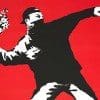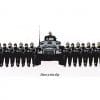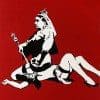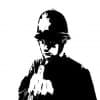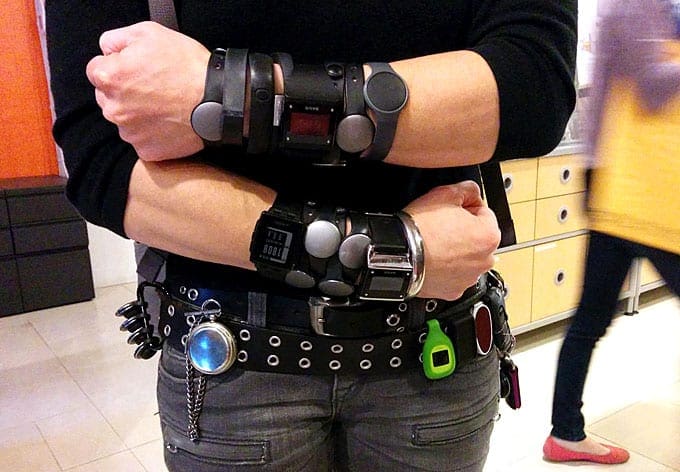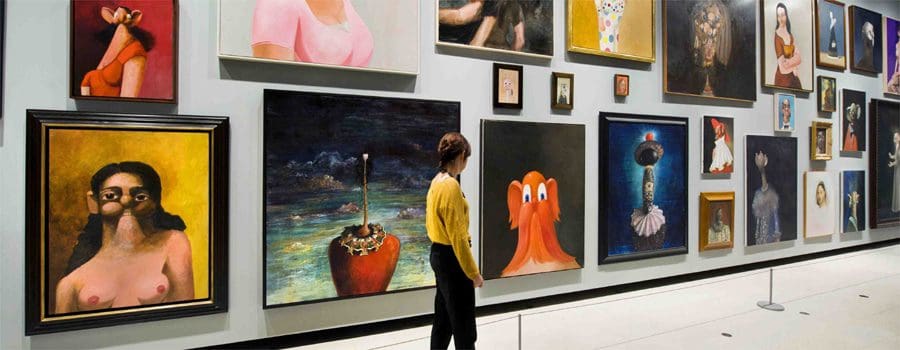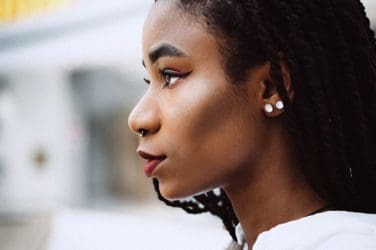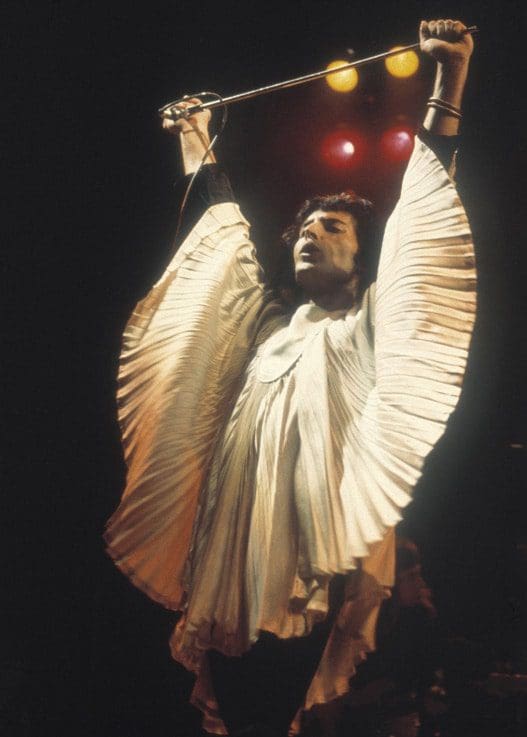A Banksy collector on collecting Banksy Words by Jade Angeles Fitton
These days a Banksy can go for up to $1.7 million, as seen with his record-breaking piece Keep It Spotless — a collaboration with Damien Hirst, but back in the early 2000s you could pick up a Banksy print for the price of a couple of pizzas.
Simon began collecting Banksy in the early 2000s while he was training to become a solicitor. Spending ten years living in Bristol, the hometown of the (now world-famous) anonymous Street Artist, he fell in love with Banksy’s works in a very organic way.
Simon first noticed Banksy while walking the city’s streets and noticing art on the walls like nothing else he’d seen before, ‘I became aware of Banksy as I’d seen his graffiti on the street – the one I remember was the image of the leopard crawling out of the broken bars – and there was no one else doing street art like that, everyone else was just tagging their names.’ This was back when Banksy was part of the DryBreadZ crew, as Simon says, ‘Back then it seemed as if everyone in Bristol was friends with Massive Attack or Banksy. I was told it wasn’t just Banksy ‘solo’, certainly not at the start, there was a group of them.’ The Banksy identity of course was always part of the mystery.
Eventually, during his wanderings Simon encountered The Greenleaf Bookshop on Colston Street, ‘It was opposite the Royal Infirmary…and I saw Banksy’s prints in there and ended up buying five – they were about £25-30 each. I bought them just because I liked them, they excited me. If I’d been buying for profit I would have bought a lot more of them – I’d certainly have bought some of the ones I didn’t like, but also more copies of the ones I did.’
These humble beginning were the start of Simon’s journey into collecting Banksy, which has taken him further than he could’ve ever imagined (and rewarded him even more so) when he picked up a few prints going for twenty-five pounds each …
Pieces Simon Bought:
Flower Thrower – ‘The Flower Thrower is such an amazing image anyway and it was already quite an iconic even at that point. You instantly recognize it.’
Queen Victoria – ‘I quite liked the perversion of Queen Vic – I’ve shown it to quite a few people who are quite elderly who were in the military and they always seem to find it amusing…’
Bomb Middle England – ‘That was actually the one I liked least of all of them to tell you the truth, personally.’
Have A Nice Day – ‘The policeman with the smiley face, it just made me laugh.’
Rude Copper – ‘The Rude Copper was of an edition of 1 of 250, and on very fragile newsprint paper.’
‘It’s very hard to say what attracted me to these prints in particular — it’s difficult to define what attracts us about a visual image other than it’s striking and more striking than the other ones that were for sale at the time. In The Greenleaf Bookshop there were also prints like Golf Sale – the image of Tiananmen Square, Apache — but as I was buying for myself, for my own aesthetic, I didn’t really fancy them on my wall (it’s just a bit boring isn’t it?) But in hindsight I would have bought a more prints: the ones I didn’t like, as well as some more copies of the ones I did. They were all part of limited edition runs.
There were others I chose not to buy but I can’t recall what they were off the top of my head, but I’d been walking past the shop quite regularly and I saw the Rude Copper in the window and that’s how I got it buying Banksy, so it was a total chance thing.
If you’re buying in today’s urban arts market amd you see any Banksy art for sale in an urban art gallery, it’s worth noting (for peace of mind) that Banksy has his own authentication agency called Pest Control, so any work you have purchased or are thinking of purchasing, it’s worth running past them. Also, you when you buy a Banksy print, check the edition number (certainly check it has one) and if it is a signed print, look for the signature too. You should get a certification of authenticity – keep that safe! That is essential if/when you ever want to sell your piece.”
Aftercare:
‘At the time, I think most people who were buying Banksy prints just used to stick them on their walls with blue tac; I decided to get mine framed – I think the guy at the framing shop must have thought I was mad framing these prints […] but apparently the best thing to do is to put them in a folio, as even the acid free tape they use to glue the prints to the back of the frame can slightly damage the paper — it will pull some of the fibers off the back of surface of the paper. You can end up in a situation with highly sought after wine and cars and paintings: you end up with wine you can’t drink, cars you can’t drive, and paintings that can’t go on walls. For me it was also very important I enjoyed owning these prints.
I think art needs to be looked at, so I think you need to talk to your framer to find out a way that’s going to conserve the back and the front most effectively, but if it ends up that you’re going to damage the back a bit, I think you should take the hit rather than leave them in a folio and not look at them, it didn’t make a great deal of difference for me. It would have been nicer to achieve more but I don’t see the point in keeping them in a folio or in a vault under your bed and taking them out and looking at them from time to time.
I’d also advise insuring the piece – just incase!’
Result of Investments:
Having enjoyed Banksy’s prints on his walls for the last decade or so, allowing them to accrue value at the same time, Simon decided this year it was time to put his investment to good use, ‘ We’re doing up our Regency house near Bath and it’s helping to pay for some of the renovations, and they also made a large contribution to a Mary Beale I’ve bought – a beautiful oil painting in a beautiful frame – which is more fitting for the house […] although there was a part of me that was tempted to keep the Banksy prints, well, I’ve sold them all now so it’s too late! But I couldn’t really find a place for them here.
Before I sold, I spent a long time considering the whole process and who would be best suited in helping me get the results I wanted – it wasn’t easy finding someone who would do justice to my collection. But my persistence paid off, because when I found MyArtBroker it was evident that have a lot of expertise in selling Banksy, which was exactly what I’d hoped for when starting out on this process of collecting Banksy. ‘
Results:
Simon sold Rude Copper, Flower Thrower, Queen Victoria, Bomb Middle England and Have A Nice Day through MyArtBroker’s Banksy specialist, making a 1,000% return on his initial investment!
Simon’s Thoughts on Buying for Investment:
‘Buying for profit can be a bit risky – especially if you’re a bit of a novice collector (as I was), so I’d advise buying what you like. There were some other [prints] I chose not to buy, but I can’t recall what they were off the top of my head. But I’d been walking past that shop quite regularly, and I saw the Rude Copper in the window, and that’s how I got it buying Banksy — so it was a total chance thing, but you could feel he was part of the zeitgeist.
Once you’ve bought what you like, think of it as a long-term investment as it’s unlikely the piece will surge in price overnight. When you do go to sell, make sure you spend plenty of time thinking doing your homework: Who is the best broker for you? Who can place the piece best for you? And who can get the best price for you — while at the same time being realistic about your ideal asking price – it’s important to make sure you’re buying from someone you trust.
If you’re a fan of street or urban art in general, and considering why you should by a Banksy over someone else, it’s worth remembering: as anonymous as he is, he is an established brand now and therefore, a relatively low-risk investment compared to someone more unknown.
As mentioned before, I stuck with my gut and only bought the pieces I liked from – and as it turned out, the more politically motivated (such as Napalm and Golf Sale) prints by Banksy, the ones I didn’t like so much, often sell for less, or take longer to sell. But as I say, go with your gut; if you like those ones, buy those ones. All things in the art market are in flux, things could change, so buy what you like as it also may not sell immediately, so you will have to live with it and it might as well be something you’d enjoy on your wall.’
Always buy and sell Banksy artwork through reputable dealers, such as MyArtBroker.
A Banksy collector on collecting Banksy Words by Jade Angeles Fitton


